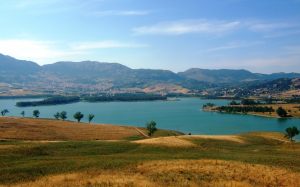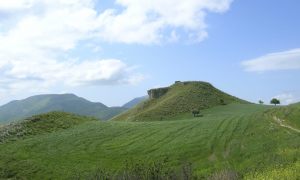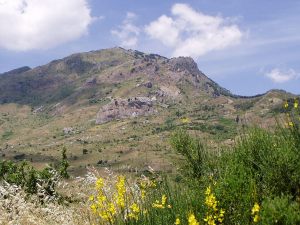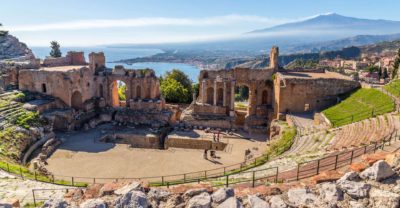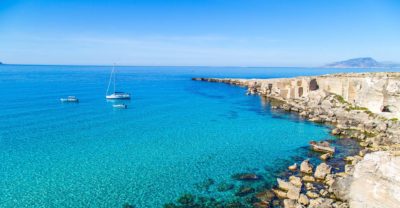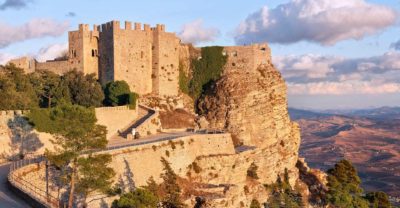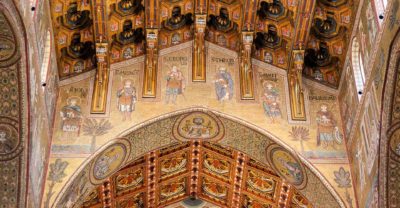Nature tourism
Palermo
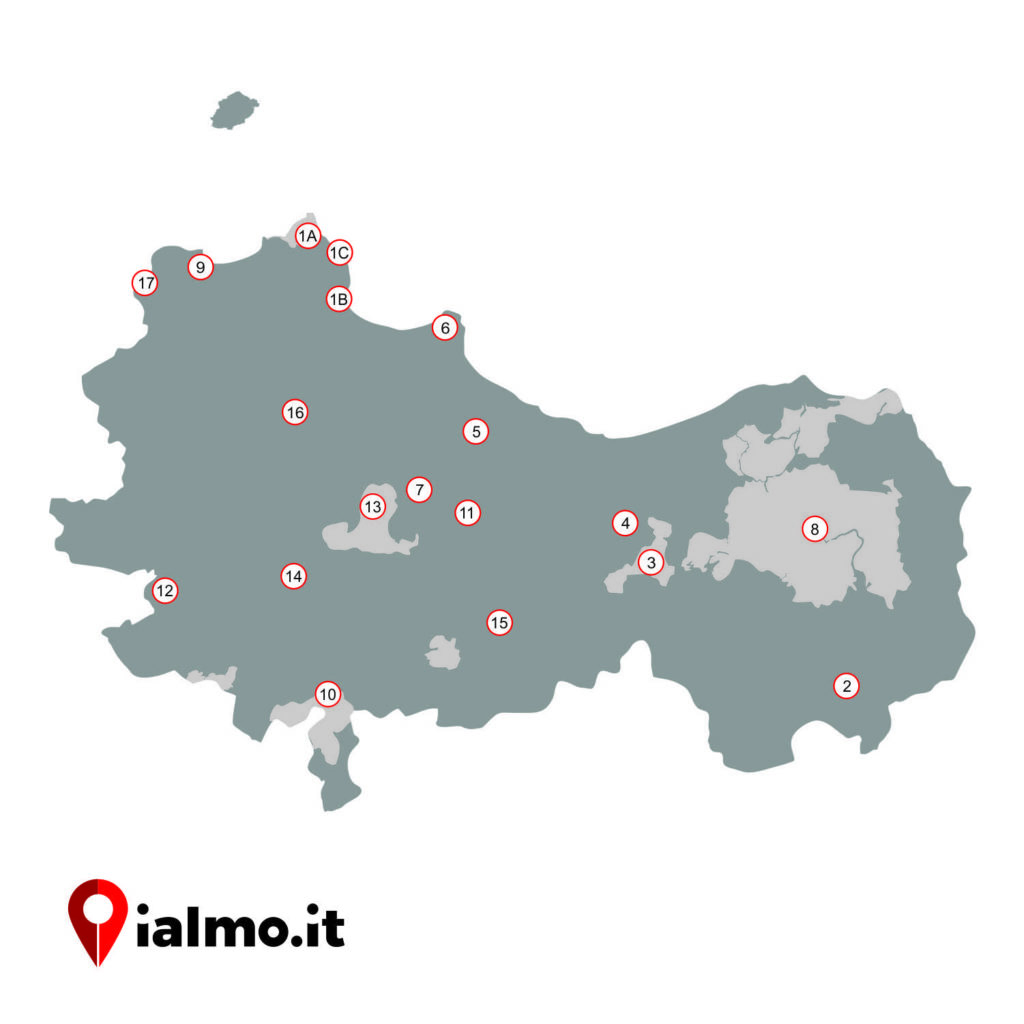
Reserves and green areas of Palermo, Palermo: There are numerous nature reserves established within the municipal area: Capo Gallo oriented nature reserve (1A): includes the entire promontory of Monte Gallo, located between the villages of Sferracavallo and Mondello. It is possible to admire stretches of rocky coast, carbonatic cliffs and traces of Mediterranean scrub; Grotta Conza Nature Reserve (1B): the Reserve, located on Pizzo Manolfo, preserves the Mediterranean natural environment and protects various species of bats; Monte Pellegrino Nature Reserve (1C): includes the entire promontory of Monte Pellegrino and the Parco della Favorita. Established in 1996, it protects the existing karst cavities and endemic plant and animal species; Grotta della Molara nature reserve: located near the western suburbs of Palermo, on the slopes of the Billiemmi mountain group, it is one of the most interesting naturalistic areas of western Sicily. Of great scientific and historical value, the Reserve protects paleontological, paletnological and archaeological evidence and hosts numerous species such as invertebrates, cavemen and bats. The municipal territory of Palermo is also rich in villas, parks and gardens: Foro Italico: it is a large area overlooking the sea and includes lawns, palm gardens, Italo Rota sculptures, a cycle path and areas reserved for dogs; Garden of the Righteous: it was inaugurated in 2008 in substitution of the pre-existing Garden of the Laurel to honor the “Giusti siciliani” who passed through history for saving Jews during the years of the Holocaust. The area is inspired by the xirbe of the twelfth and thirteenth centuries; Villa Giulia: in neoclassical style, it was built between 1777 and 1778 at the request of the Praetor of Palermo, the Marquis Antonino La Grua. The long tree-lined avenues host painted exedrae, temples, allegorical statues, the Dodecahedron clock, Ignazio Marabitti’s Fountain of the Genius and various symbolic-esoteric works of value; English Garden: designed in 1851 by Giovan Battista Filippo Basile, it is inspired by the style of the English garden full of fake ruins, bridges, stone basins, small temples, greenhouses, pergolas and statues. It conserves works by Ernesto Basile, Benedetto Civiletti, Vincenzo Ragusa and Mario Rutelli; Giardino della Zisa: built in 2005, the garden is crossed by a system of water tanks and twelve “dammusi”;Parco d’Orleans: built at the behest of Louis Philippe d’Orleans in the early nineteenth century, it was purchased by the Sicilian Region in 1955 which transformed a part of it into the ornithological park. It hosts a pond with ducks, multiple species of exotic and Mediterranean birds, fallow deer and antelopes; Botanical Garden: was established in 1786 as an extension of the first botanical garden built in 1779. The buildings of the main entrance body were designed in neoclassical style by Léon Dufourny. It welcomes over 12 thousand different species of plants, some particularly rare and is one of the largest botanical institutes in Europe; Parco della Favorita: located between the Piana dei Colli and Mondello, it is one of the largest parks in Europe. It was created in 1799 by Ferdinand III of Bourbon who made it a Real Estate used as a hunting reserve, to agricultural experiments with large cultivations of citrus fruits, olives, ash, walnuts and sumac and to place of pleasure of the Bourbon court; Parco Auditore: inaugurated in 2012, it is the site of several city events; Villa Malfitano Whitaker: houses rare plants from countries such as Tunisia, Sumatra and Australia and a nursery with about 150 specimens of orchids; Giardino della Memoria: inaugurated in 2005 in the fraction of Ciaculli, commemorates all the fallen in the fight against the mafia; Park of Villa Niscemi: home of the Municipality, the garden is rich in many sub-tropical species including ficus, palms, yucca and dracene. In the green area there is a pond.
Parco della Mazza, Alimena: it covers a total area of about 7.5 hectares and has an important biodiversity with numerous trees and plants (about 12,500). Includes a picnic area, a children’s playground area and a natural amphitheater. The so-called “Strittu”, a gorge, can also be reached in the municipality of Alimena. It can be reached by walking for about 4 km, where the river Salso narrows and offers a beautiful landscape characterized by limestone boulders, water jumps, walls with sulfur outcrops and small natural pools. At the source of the Strittu are attributed by many alimenesi thaumaturgical properties against dermatosis.
Nature Reserve oriented Bosco di Favara and Bosco Granza, Alimusa-Cerda-Montemaggiore Belsito-Sclafani Bagni: established in 1997, it is characterized by the presence of cork, oak and holm oak woods. Significant is the marsh and lake vegetation located in the Bomes coarse pond. Numerous also the mammals that inhabit the territory of the Reserve: the wild boar, the deer, the fox, the marten, the weasel, the wild rabbit and the hedgehog.
Giuseppe Giovanni Battaglia Literary Park, Aliminusa: dedicated to the local poet who courageously denounced the social injustices suffered by the peasants of his homeland. Inside the Park there is a market area for the marketing and tasting of local products, the peasant zoo to make known to the youngest specimens of animals an expression of the rural world (hens, rabbits, sheep, goats, donkeys, mules and geese) and the Contadine Museum Houses.
Nature reserve oriented Pizzo Cane, Pizzo Trigna and Grotta, Altavilla Milicia-Baucine-Caccamo-Casteldaccia-Trabia-Ventimiglia of Sicily: overlooking the Tyrrhenian Sea, is a protected area of over 4,500 meters which boasts picturesque and varied naturalistic landscapes in which damp and green leave the pace to other more rocky. The flora presents few specimens of large trees, with rare exceptions of oaks and oaks. The landscape is full of vast expanses of grass and shrubs that have colonized the walls of the mountains. The fauna present in the Reserve has a good number of sea urchins, porcupines, wild cats and weasels while the birdlife can count on the prestigious presence of the golden eagle. In the Reserve there are three different caves (the Mazzamuto cave, the Brigli cave and the Leone cave) where traces of prehistoric settlements have been found.
Park of Monte Catalfano, Bagheria: is an oasis of peace of about 300 hectares that extends north of the town of Bagheria. The Park area consists of three areas: the area of the slopes, the area of landfills and high-altitude areas where numerous paths, through the Mediterranean scrub and reforested areas, offer scenic routes that connect the natural caves to reach the mouthpieces of the “Zubbi”. The latter would have been formed at the beginning of the Pleistocene (the Quaternary period, ranging from 1.8 million up to 10 thousand years ago), when Monte Catalfano was a small island immersed in the sea. Climbing up to 400 meters high, the view opens with a breathtaking view of the Gulf of Palermo. With its floristic and landscape peculiarities, the Monte Catalfano can be called the green lung of Bagheria.
Nature reserve oriented Bagni di Cefalà Diana and Chiarastella, Cefalà Diana-Villafrati: in the area of the Nature Reserve, established by the Regional Councilorship of the territory and the environment in 1997, the carbonate relief of Pizzo Chiarastella and the source of thermal water of Bagni that in the past flowed between Pizzo Chiarastella and Cozzo Cavallo and reached the building known as “Arab Baths”. Very suggestive, the building of the Arab Baths is an example of thermal architecture of probable Muslim manufacture as evidenced by the remains of the decorative band and the graphic and floral forms that adorn the outer wall of the baths. The Mediterranean scrub characterizes the area of the Reserve: Chiarastella lace is surrounded by a vast prairie and by different types of flowers from liliacea to asphodelina, from the thorny broom to the orchid. Among the birds there are the bee-eater, the cappellaccia, the Sardinian sparrow and it is also possible to spot different species of diurnal and nocturnal birds of prey.
Madonie Park (Caltavuturo, Castelbuono, Castellana Sicula, Cefalù, Collesano, Geraci Siculo, Gratteri, Isnello, Petralia Soprana, Petralia Sottana, Polizzi Generosa, Pollina, San Mauro Castelverde, Scillato and Sclafani Bagni): is a Regional Natural Park established November 9, 1989 and which includes fifteen municipalities of the metropolitan city of Palermo. It hosts more than half of the Sicilian plant species and most of those present only in Sicily as the endangered Abies nebrodensis. With regard to fauna, more than 50% of bird species are present, all species of mammals and more than 50% of the species of Sicilian invertebrates. Thanks to the remarkable geological interest linked to the Madonite mountain range, since 2003 the Madonie Park has become part of the European Geopark network, which includes more than 20 European geological and non-geological parks. The site was included in the list of UNESCO World Geoparks on November 17, 2015. Within the Park and particularly in the territory of the town of Scalfani Bagni we point out the spa built in 1857 on the remains of a previous plant destroyed by a landslide. Today it is owned by the Municipality, it is the only structure of this type present in the Madonie Park.
Nature reserves at Carini, Carini:
Grotta di Carburangeli Nature Reserve: located near Villagrazia di Carini, there have been found numerous fossil remains belonging to extinct or disappeared species from Sicily such as the elephant, the bear, the hyena, the bison and the deer.
Grotta dei Puntali nature reserve: the cave opens into the Mesozoic calcareous rock of the slopes of Monte Pecoraro and is of great paleontological and naturalistic interest. The site also represents an important station for the survival of a colony of bats and houses a cavernicola fauna consisting of troglophile and troglossone species.
Park of the Sicani Mountains (Bivona, Burgio, Cammarata, Castronovo di Sicilia, Chiusa Sclafani, Contessa Entellina, Giuliana, Palazzo Adriano, Prizzi, Sambuca di Sicilia, San Giovanni Gemini, Santo Stefano di Quisquina): definitively established in 2012, it is the fifth Regional Park of Sicily and includes several pre-existing natural reserves which, together with the Park, they were suppressed by decree. Three of these reserves belonged to the territory of Palermo: the Nature Reserve oriented to Monti di Palazzo Adriano and Valle del Sosio, the nature reserve oriented Monte Carcaci and the nature reserve oriented Mount Genuardo and Santa Maria del Bosco. The Park crosses 12 municipalities, 6 from Agrigento and 6 from the province of Palermo. In the territory of the Park there are examples of holm oak and oak, carob, cedars, cypresses, pines, maples, endemic species such as the Sicilian dandelion, the sesleria of the macereti, the Sicilian senecio, the yellow bivonea and the camomile of the Madonie. Still the Park hosts the fox, the wild rabbit, the hare, the weasel, the porcupine, the hedgehog and the garden mouse. As for the birdlife we mention the ruler, the woodcock, the blackcap, the blackbird, the creeper, the wren, the great tit, the robin and the small luì. Among the birds of prey the kestrel, the buzzard, the owl, the owl, the tawny owl and barn owl. Finally, the presence of the great spotted woodpecker and the Sicilian partridge, two species at risk of extinction.
Serre di Ciminna Nature Reserve, Ciminna: is a protected natural area of Sicily established in 1997. The Serre di Ciminna are a relief of Messinian Selenitic chalks interesting for the karst and tectonic structures, for the flora of the chalky walls and for the avifauna . In the territory of the Reserve alternate sections of prairie, garrigue, scrub and rock vegetation and there are shrubs such as the olive, the shrubby wormwood, the Sicilian sumac, the shrubby teucrium, the spiny broom and the odorous broom. In spring it is possible to observe the flowering of different species of wild orchids. In the territory beneath the rocky walls of the Serre there are some mammals such as the porcupine, the fox and the wild rabbit. Also present some species of birds of prey including the buzzard, the kestrel and the lanner. Among the species of avifauna also worth mentioning the Sicilian partridge.
Grotta di Entella Nature Reserve, Contessa Entellina: it is a protected natural area that includes a suggestive karst cave which can be accessed by booking at Cai, the reserve managing body since 1995. Inside the cave it is possible to admire stalagmites and gypsum worked . The Reserve also hosts a significant fauna patrimony and records the presence of a rich Mediterranean scrub.
Oriented nature reserve of Rocca Busambra and Bosco di Ficuzza, Corleone-Godrano-Marineo-Mezzojuso-Monreale: a protected natural area established in 2000 by the Sicily Region. The Reserve covers a total area of about 7,400 hectares and is dominated by the limestone massif of Rocca Busambra. The whole area is rich in torrential rivers that form several natural ponds, the so-called “gorghi”. Within the territory of the Reserve there are various accommodation facilities such as the Real Casina di Caccia di Ficuzza, the Regional Center for the Recovery of Wildlife, the Ethno-Anthropological Museum Godranopoli di Godano, the Rifugio Alpe Cucco and the Rifugio Val dei Conti.
Gorges of the Dragon, Corleone: along the road that connects Ficuzza with Corleone you reach an old bridge crossed by the torrent Frattina. The stream has crossed over time the rock forming chasms, reels and small waterfalls. The so-called “Giants’ potholes” are very large, cylindrical and deep holes where the water is whirling. Where the slope decreases, pools of clear water are formed where it is possible to swim among the ferns, the maidenhair, willows and elms, also present tortoises, fish, and dragonflies. Noteworthy in the area is the Waterfall of the Two Rocche where you arrive through a path full of poplars, willows and elms that from the streets of the San Giuliano district leads to the waterfalls. The rocks are occupied by rock vegetation and on the walls you can see the remains of an ancient aqueduct.
Zolfara Industrial Archaeological Park, Lercari Fridda: was established in 1993 to honor the rich tradition developed around the mining industry. The territory of the Park includes the areas of extraction and processing on the hill Madore, today an element of cultural and tourist attraction.
Lake of Piana degli Albanesi, Piana degli Albanesi: symbol of the city, the lake of Piana degli Albanesi is actually an artificial basin. The reservoir was built in 1923 with the construction of the dam on the Belice river, the first in Sicily, between the Maganoce and Kumeta mountains. The expanse of water extends over a surface of 40 km² and is destined to use hydropower, agricultural and hydroelectric. Tourist destination, the lake hosts various sporting events and is surrounded by hiking trails and cycle paths. The Serre della Pizzuta nature reserve is also worth mentioning in the municipality of Piana degli Albanesi.
Capo Rama Nature Reserve, Terrasini: is a natural area established in 2000 by the Sicilian Region. The Reserve occupies an area of about 57 hectares and includes the promontory of Capo Rama and the surrounding coastal areas including the wonderful beaches of the town of Terrasini. The Reserve is accessed from Contrada Agliandroni.
